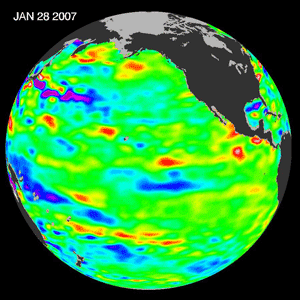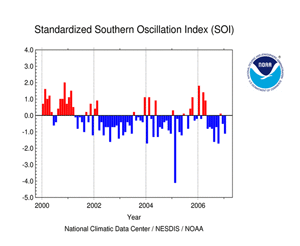EL NIÑO EVENT WEAKENS:
SSTs COOL ACROSS THE EQUATORIAL PACIFIC
SSTs COOL ACROSS THE EQUATORIAL PACIFIC
|
|
Sea-Surface Temperatures
(SSTs) and
Mixed-Layer Conditions: The area of Sea-Surface Temperature (SST) anomalies greater than +1.0°C (+1.8°F) diminshed over the past month, with the warmest anomalies persisting from approximately 120°W to the South American coast in January. Water temperatures in the mixed-layer also decreased in January, with an area of +2.0°C (+3.6°F) and greater temperature anomalies in the top 100 meters of the mixed layer in the eastern equatorial Pacific. In addition, a layer of cooler water below 100 m depth continued to develop and spread further eastward in January. For the month, the SST anomaly in the Niño 3.4 Index region was +0.70°C (+1.26°F) in January, which was a decrease of -0.67°C (-1.21°F) compared to the December anomaly. The SSTs in the Niño 4 Index region of the western equatorial Pacific also cooled during January to a monthly anomaly of 0.77°C (+1.39°F) above the mean (map of Niño regions). For the most recent global ocean surface temperatures, please see the loop of satellite-derived weekly SST anomalies for January 2007. Despite the decrease in the SST anomalies in the Niño 3.4 index region, by the end of January the 3-month running mean remained well-above the +0.5°C (+0.9°F) threshold that indicates the presence of an El Niño episode (NOTE: For NOAA's official ENSO classification scheme, please see NOAA's El Niño/La Niña Index Definition). The Climate Prediction Center's most recent ENSO Diagnostic Discussion indicated that the warm event (El Niño) had reached maturity at the end of 2006 and has shown signs of weakening over the past month. The ENSO forecast from the Australian Bureau of Meteorology (BoM) also reflects the weakening of warm event conditions in the tropical Pacific basin during the first few months of 2007 (see the Australian BoM ENSO Wrap-Up). |
|
|
Equatorial Zonal
Winds (U-Component Winds) and Sea-Level Topography: Anomalous westerly winds were observed across the far western equatorial Pacific during January, while the easterly Trade winds were above normal across the central and eastern equatorial Pacific. Significant week-to-week variability in the near-surface winds has been observed along the equatorial region of the Pacific over the past month, as shown in the loop of January zonal winds. A period of anomalous westerly flow occurred in the central and western equatorial Pacific region during mid-January, as easterly Trade winds persisted across the eastern equatorial Pacific basin during the past month. Pacific sea levels measured by the NASA/JPL Jason-1 satellite were above average across the eastern equatorial Pacific in mid-January, reflecting the warmer-than-average ocean temperatures and the mature phase of the El Niño event. However, by the end of January the positive sea level anomalies had dissipated as sea levels were again near average (see the most recent image of 28 January 2007 sea level anomalies). |
|
|
Outgoing
Longwave Radiation (OLR): The map to the left shows the spatial pattern of global OLR (in W m-2) measured by satellite during January. A large region of negative OLR anomalies was observed in the western equatorial Pacific near the Date Line, illustrating the enhanced tropical convection in this region. The monthly OLR index for January was -1.2 W m-2 averaged across an area in the western Pacific between 160° E and 160° W. This was the sixth consecutive month that the OLR index was below the long-term mean. Persistently negative OLR indices are typical of the mature phase of an El Niño episode. As of early February, NOAA's Climate Prediction Center (CPC) has forecasted the current El Niño episode to dissipate during March-May 2007 (click here for CPC's ENSO Diagnostic Advisory Archive. Therefore, it is expected that the monthly OLR Indices will evolve toward zero (near-neutral), as the Walker Circulation shifts to the west and tropical convection in the central equatorial Pacific weakens during the first few months of 2007. Note that high frequency variability in OLR is typically associated with the Madden-Julian Oscillation (MJO, which is convective activity that propagates west to east in the near-equatorial region from the Indian Ocean into the Pacific Ocean approximately every 30-60 days). The latest MJO activity can be seen in CPC's graphs of Daily MJO Indices. |
| Southern
Oscillation Index (SOI): The standardized SOI was -1.1 in January. The SOI has shown considerable variablity over the past three months with a near-neutral value in November, and a shift to a negative value in December. This recent period of variability followed six consecutive months with negative index values [note that consistently negative (positive) values of the SOI are typical of El Niño (La Niña) conditions]. A transition to neutral SOI values are expected over the next few months, as NOAA's Climate Prediction Center (CPC) has forecasted the current El Niño episode to continue to weaken during March-May 2007. |
Additional Links
- ENSO Monitoring
- NOAA El Niño / La Niña Index Definition
- NOAA's Pacific Marine Environmental Laboratory (PMEL):
- NOAA's Climate Prediction Center (CPC):
- NOAA's Physical Science Laboratory
- NASA/JPL Ocean Surface Topography from Space
- Australian Bureau of Meteorology (BoM) Climate Driver Update
- IRI - International Research Institute
 NOAA's National Centers for Environmental Information
NOAA's National Centers for Environmental Information






 Larger image of
January OLR Anomalies
Larger image of
January OLR Anomalies Larger image
of November-January OLR Anomalies
Larger image
of November-January OLR Anomalies Larger image of
January OLR Index
Larger image of
January OLR Index